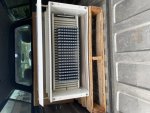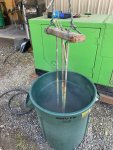loosegravel
Just a retired mechanic who's having fun!
- 504
- 893
- 93
- Location
- Enumclaw, Washington

I've been buying and selling the MEP generators for a couple of years now. When I "show" one to a perspective buyer I usually connect it to my shop main panel where I can turn on various different breakers to show that it's producing power. I've been looking for a load bank for a while now, and also kicking around the idea of building one. I bid on a couple of "braking resistors" that I saw on Iron Planet yesterday. Not knowing what they really were, I took a chance. Well of course I won them both. They're brand new "Gino ESE" braking resistors. The identification plates have them at 1.5 ohms, 1100 volts and 1400 amps. Of course that's way to "hot" for load testing these marvelous MEP generators. But using ohms law if I supply 208vac across something that's 1.5 ohms that comes out to a little over 138 amps or 28.5kw. That's still a little to hot for the smaller generators. But I'm wondering if I could reconfigure something like this to have individual, smaller loads and use 20 amp toggle switches to apply them? Also, there is a bolt on one end of the box that sandwiches all of these plates together. It looks like it could also be used like a "carbon pile" DC load tester, only it would be A/C instead. I'm just wondering if anyone here has any experience with using a braking resistor as a load bank. Maybe I have essentially purchased a couple of $200 boat anchors! Ahh yes, it wouldn't be the first time!



